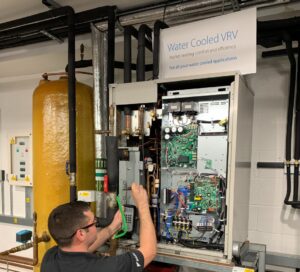The energy sector is at a crucial stage in its evolution, as rapid developments in Internet of Things (IoT) and related technologies continue to challenge its outdated infrastructure.
This, coupled with the global push towards renewable energy, is further threatening the reliability of traditional suppliers. It is also increasing the need for companies to streamline their operations, to accommodate multiple energy sources and improve the efficiency of their supply.
With global investment in IoT technology expected to surpass $60 trillion over the next 15 years, the opportunities to leverage this technology, in an effort to innovate services for the future are huge.
Beyond the smart meter
The evolution of IoT offers energy companies numerous ways to enhance productivity whilst generating substantial cost-savings. One of the most prominent, and perhaps most simple, introductions of IoT within the sector to date is the emergence of smart meters.
These are installed in buildings to send digital meter readings to suppliers and help users monitor their energy consumption. A report by BI Intelligence predicts that utility companies will collectively save up to $157bn by 2035 through the use of these devices, outlining the huge potential of such IoT technologies across the industry.
While devices like smart meters and sensors can be widely installed across buildings to complete relatively simple tasks, such as monitoring room temperature, the application of more complex IoT solutions – which facilitate automation on an industrial scale – can further improve energy efficiency at source.
For instance, by integrating IoT across vast internal infrastructures such as power plants, suppliers can transform how they complete manual processes which are often seen as both time and labour intensive.
For energy suppliers, simplifying processes through the use of a connected IoT system can provide predictive maintenance and improve outage management, offering a significant degree of stability in an ever-evolving and unpredictable market.
Renewable energy
The global push towards renewable energy sources has paved way for new entrants to capitalise on the growing preference towards alternative energy services.
However, naturally with this growth comes the need to improve the sustainability of services to ensure continued productivity on a global scale.
As a result, the number of multi-service energy companies, all of which require flexible, bi-directional networks to simplify the process of managing multiple energy types, has also increased. While the integration of industrial IoT technology in renewable energy is still in its infancy, a widespread uptake of IoT will enable suppliers to create two-way power flows which can smoothly accommodate new energy sources with a greater level of flexibility.
The benefits of IoT can be applied to other processes, such as improving the management of on-site energy generation or a more streamlined means of electric vehicle charging. This not only demonstrates IoT’s versatility across the renewable energy sector, but offers traditional energy companies new ways to transform and differentiate their services.
Applying IoT
IoT applications can also be implemented to collect real-time data. By installing devices on machinery such as wind turbines, suppliers can track the performance of generators, enabling them to collect important operational data and resolve issues before they appear.
The major challenge for energy companies when integrating IoT technologies is finding a connectivity which offers both security and simplicity.
One compelling solution is unstructured supplementary service data (USSD). This universally available feature, present within all GSM mobile networks, can essentially act as an internet without the internet for industrial solutions, with no TCP-IP required.
Its ubiquity enables providers to track the performance of energy supplies with full connectivity, even if mobile data cannot be attained. Accessible and available at a substantially lower cost than alternatives, USSD could satisfy global and nationwide energy suppliers by allowing devices to be produced and installed on a wide scale.
Further, USSD uses significantly less power, enabling devices to run much longer compared to other data-centric solutions, and offers security by establishing a direct channel between the sender and recipient, to reduce the risk of interception and therefore the likelihood of outages.
Given its huge potential to improve efficiency across the sector, a greater recognition of IoT by energy suppliers is crucial to ensuring its future growth and evolution.
With the future of the industry pushing more towards the sustainable, USSD offers existing suppliers an effective way to innovate and secure future market share, and renewable energy companies the opportunity to manage and maintain their rapid growth.
















